Micro-Hydro Power: Is It Right for My Farm?
By Leif Kindberg, NCAT Farm Energy Specialist
Abstract
Micro-hydro power projects can sustainably harvest energy from on-farm water resources and produce mechanical and electrical power. Low-impact, nonconsumptive, and “run-of-river,” micro-hydro systems can produce renewable power for 20 or more years. This introduction to micro-hydro power will help guide you through the basic considerations for developing a micro-hydro project.
Table of Contents
Introduction
Step 1 — Will Your Resource Meet Your Needs?
Step 2 — Can You Use the Water Resource?
Step 3 — Calculate the Costs of the System
Step 4 — Compare the Costs of Alternatives
Step 5 — Financing Considerations
Step 6 — Start the Permitting Process
Step 7 — Build or Buy the Equipment
Step 8 — Install and Check the Equipment
References
Further Resources
Introduction
Micro-hydro power is one of the most reliable and consistent sources of renewable energy available. A good water resource with a year-round flow and several feet of elevation drop can provide years of continuous power.
This introductory publication discusses the steps necessary to develop the potential power in a water resource. It does not, however, provide answers to the technical questions you may have about developing a micro-hydro power project. You will want to refer to a more technical do-it-yourself ATTRA publication, Micro-Hydro Power: A Beginners Guide to Design and Installation, if you are planning to install your own micro-hydro system.
Step 1 – Will Your Resource Meet Your Needs?
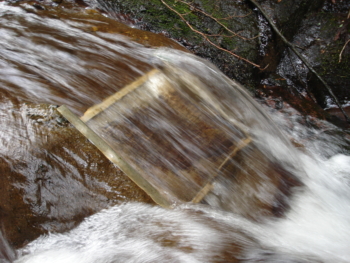
A micro-hydro intake and penstock temporarily divert
a portion of the water flow and carry it to the location of the turbine. Photo: Leif Kindberg, NCAT
If there is not enough energy available in your stream to come close to meeting your energy needs, there is not much sense in going any further. On the other hand, the stream may contain enough developable power that you will want to use only a portion of it. In order to determine your stream’s potential power, you will have to quantify the head and the flow rate.
Head is usually defined as the vertical distance between the point where you will collect water (the intake) and the point where you will install a turbine. There are usually only a few possible locations near the water resource for the turbine and generator, while there may be several possible locations upstream for the intake.
Flow is the volume of water that can be temporarily diverted to the hydro turbine. It is usually measured in gallons per minute (gpm) or cubic feet per minute (cfm). Keep in mind that it is best to take as little water as possible from the source.
If you are already familiar with how to calculate head and flow, you are ready to move forward. If not, review the ATTRA publication Micro-Hydro Power: A Beginners Guide to Design and Installation.
Power output is directly related to the flow rate, head, and force of gravity. You will need to calculate the potential power output of your system in order to determine whether it can meet your power needs. You can roughly calculate potential output with this formula:
Watts = Head (in feet) x Flow (in gpm)/12*
*This figure, a measure of efficiency, may range from 9 for larger AC systems to 13 for smaller battery-based systems.
It is also necessary to understand thoroughly the type of energy you need. If you are considering mechanical shaft power as your end use (e.g., sawing or grinding), you need to know the power requirements of your machinery, probably measured in horsepower. If you want to use the energy available in the water to generate electrical power for lights, your shop, or motors, you have to determine your electrical-power needs. The best way to do this is to look at your current electricity bills to get an idea of the number of kilowatt hours you are using each month. Remember, you will have peak power needs that must be considered when you are sizing and designing your system.
Once you have determined your power-generation potential and your power requirements, compare the two to find out whether your water resource can meet your energy needs. If your monthly power requirements are greater than the hydropower system would generate in a month, consider whether you are able to reduce consumption to try to match the available power through increased efficiency or by using different equipment. It may be more cost effective to spend some money on equipment that is more efficient rather than on greater energy-generation capacity. On the other hand, if your system’s output would be greater than your demand, you may have surplus power for such other end uses as space heating, water heating, or selling power to your area’s electricity provider.
It is important to note that there are heads and flow rates below which it most likely is not economical to develop a water resource. These minimum heads and flow rates are difficult to specify because combinations of a lot of one and not very much of the other can provide plenty of useful power. For practical purposes, however, any head less than 10 feet is probably going to be uneconomical to develop in micro-scale hydroelectric systems. Similarly, 10 gallons per minute can be considered the lower limit of the flow rate. However, 10 gallons per minute at 10 feet of head is not going to generate enough usable electrical power. The following examples will help you consider some minimum-energy situations:
- A flow rate of 10 gallons per minute at 100 feet of head will produce about 83 watts of useful power before efficiency losses — enough to light an 80-watt light bulb pretty much continuously.
- A flow rate of 100 gallons per minute at 10 feet of head also will deliver about 83 watts of useful power.
A good water resource needs either a larger flow or higher head than the previously suggested minimums. Combinations of head and flow above the minimums can provide plenty of usable power, and there are a number of turbines that are specifically developed to be used at sites with very limited resources.
Step 2 – Can You Use the Water Resource?
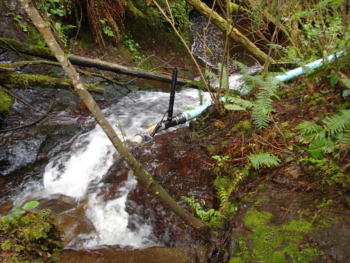
A micro-hydro intake and penstock temporarily divert
a portion of the water flow and carry it to the location of the turbine. Photo: Leif Kindberg, NCAT
Do you have a right to use the water, or does that right reside elsewhere? Remember that in many states, particularly in the West, water rights do not necessarily transfer with land titles, and downstream users may also have a legal right to the water. The water-use permitting process can be long and drawn out, so for now just investigate the feasibility of using the water resource at your site.
Another important consideration is the environmental impact caused by using water for hydropower. Micro-hydro projects are usually “non-consumptive,” that is, they temporarily divert water from the stream and then return it after it passes through the hydro turbine. There will be a limit on the volume of water that can be temporarily diverted from many on-farm water resources. Taking too much water or damming up a stream can cause long-lasting environmental damage, including reduced in-stream flow, increased water temperature, altered fish habitat and stream ecology, and barriers to fish passage. In many areas, these environmental impacts will prevent a water resource from being developed.
Step 3 – Calculate the Costs of the System
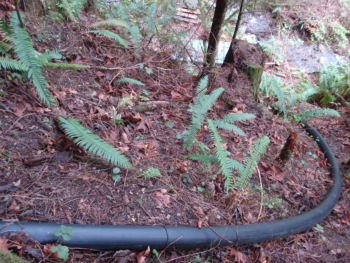
The penstock is sized and selected for each site. Often, a pressure-rated steel or plastic pipe is used. Photo: Leif Kindberg, NCAT
If you have a water resource that is worth developing, determine who the equipment suppliers are for that type of water resource and evaluate your equipment costs. (A list of equipment dealers is available from the ATTRA Directory of Energy Alternatives.) Most equipment suppliers will be able to give you a rough estimate of costs if you can supply them with the following information:
The usable flow rate (e.g., in gallons per minute or cubic feet per minute)
- The head (e.g., in feet, meters, or pounds per square inch)
- The length of the pipe (penstock) required to run from the intake to the turbine location
- The power demand required in kilowatt hours and what it is used for
- The kind of power you want to use — AC or DC — and what you want to do with any surplus power
- The transmission-wire length from the generator to the point of use
In your cost calculation, include dam repair or construction (if needed), the piping, laying the penstock, the electrical setup, and the construction of a small powerhouse for the turbine, generator, and electronics. In most cases, these components will be the most expensive parts of the project.
While considering the project’s costs, also take into account any peripheral advantages from a hydropower system. These may include using the penstock as a source for domestic water, irrigation water, or water for fire suppression. Can any of these benefits offset other costs you have or expect to have? How does this affect the cost figure associated with the hydropower system?
The next question that arises is this: Are the costs of the system reasonable?
This question can be answered only by knowing your own reasons for developing a micro-hydro system. Your noneconomic reasons (e.g., environmental effects and energy independence) may outweigh any other considerations, but if you are like most of us, economics plays a deciding role.
Step 4 – Compare the Costs of Alternatives
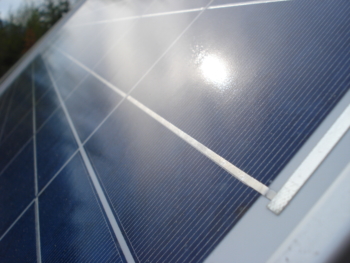
Energy alternatives like solar are not constant—
unlike many micro-hydro projects that can operate
24/7—but may be a better choice depending on the
project site and power needs. Photo: Leif Kindberg,
NCAT
Is your property currently connected to utility power lines? How much are you paying for your electricity, and would it be advantageous, economically, for you to disconnect from those lines and supply all of your own power? You can determine the economic advantage, if any, by comparing the cost of installing, operating, and maintaining a micro-hydro power system to the cost of all the various alternatives. Your micro-hydro system might be most economical option under the following conditions:
- If your site is isolated and the nearest utility lines are a mile or more away, you might find that the cost of installing a small hydropower system is very competitive with the cost you would pay to have the utility lines extended.
- If your site has a high head and/or continuous flow.
- If you can sell power back to the utility at a reasonable rate.
- If the powerhouse is located next to or very near the point where power is needed.
On the other hand, here are some situations that might make it not worth your while to develop a site:
- If you must use some power from the utility company, continuously or seasonally, the “meter charge” may eliminate any significant cost savings from your hydropower system.
- If you either cannot sell electricity back to the utility or will not continuously use the power generated by your micro-hydro system.
- If your project would require a lot of excavation, dam building, or consulting.
- If the siting and permitting requirements are time-consuming and complex.
Step 5 – Financing Considerations
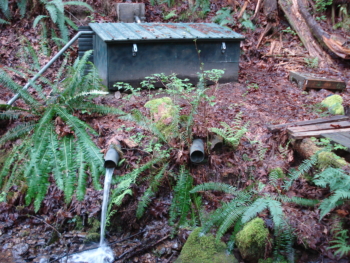
A “run-of-river” system returns flow to the same
stream, reduces environmental impact, and generally
eases the permitting process. Photo: Leif Kindberg, NCAT
The capital costs associated with micro-hydro power systems are usually not as high as they are for such other alternatives as wind power or solar power. Typically, micro-hydro costs run from $1,500 to $4,000 per kilowatt of installed capacity. The costs will vary substantially depending on your site. Your method of financing the project will determine what you will actually pay per kilowatt-hour of power you use.
You can keep the costs down by doing a lot of the work yourself. You can build and install some of the needed components, or all of them if you want to and have the time. However, be forewarned — you might close off some financing options if you do construct your own equipment and use your own labor. For example, loans are made on the basis of guaranteed collateral, and this collateral often relates to the equipment. So if the item does not have proven value — that is, if it cannot be repossessed and have a guaranteed resale value comparable to the prorated value of the loan — it may not be financeable. Furthermore, certain grant programs, such as the Rural Energy for America Program (REAP), require that technology be proven and commercially available or go through a technical-verification process.
Step 6 – Start the Permitting Process
If you have successfully arrived at this point, you are ready to obtain the necessary permits. Again, there are numerous water-rights and environmental-impact considerations that may apply to your project. Although many people have simply bypassed the permitting process when they developed a micro-hydro project, there are risks in doing so. The traditional place to start is the Federal Energy Regulatory Commission (FERC) — the agency responsible for permitting micro-hydro projects. FERC will be able to provide you with the names of many, if not all, of the local agencies you will also need to contact in order to properly permit your system. Finally, if you plan to interconnect your micro-hydro system with the utility company’s system — and such an arrangement is available in your area — you will need to obtain an interconnection agreement with the utility.
Step 7 – Build or Buy the Equipment
If you have made it this far in your planning process and feel confident that you are ready to buy equipment, here are some tips to consider.
It is important to be sure of the quality of the materials and equipment you buy. If you are looking to construct your system, you may be attracted to the equipment with the lowest cost. This may or may not be the approach to take in your particular case. Micro-hydro systems often require equipment that can withstand high pressures and high flow volumes. Homepower Magazine is a good source for researching off-the-shelf turbines and equipment, as is ATTRA’s telephone help line. Another good way to ensure that you’re getting a quality product is to ask the supplier for a list of previous customers in your area. Go to one of the sites and talk to the people using the equipment to get their opinions about it.
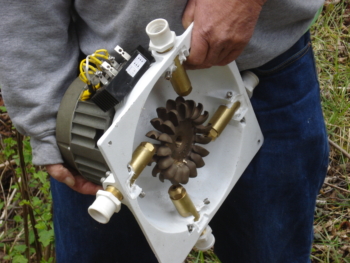
Equipment is almost always designed for the characteristics of each specific hydro site. Photo: Leif Kindberg, NCAT
Get good-quality pipe for your penstock. Do not use seconds that may not be pressure rated for your needs. Use gate valves in your system; do not use ball valves. Unlike ball valves, a good gate valve takes long enough to shut off that it creates very little “water-hammer” effect. A pressure wave — the water hammer — caused by closing off a high-pressure line too quickly can cause severe damage to the penstock and equipment. Also, a good intake setup is vital for many years of hassle-free operation. There are a number of very good off-the-shelf intakes available from equipment dealers.
Step 8 – Install and Check the Equipment
During the installation of equipment, it is important that you follow all the manufacturer’s instructions. Do not take any shortcuts. Remember that reputable manufacturers have been in the business for a while, and they know their equipment. If you encounter any problems, contact the manufacturer, and they will help you. It is in the best interests of the manufacturer that a system be installed successfully and function correctly.
If you are installing a DC system, install the turbine-generator set as close to the point of use as possible. This will keep transmission-line power losses to a minimum. If your electrical knowledge is basic, consider involving an experienced electrician.
If you have read through these simple steps, you are well on your way to developing a micro-hydro project. Once again, we recommend that you read the ATTRA publication Micro-Hydro Power: A Beginners Guide to Design and Installation and ask lots of questions of your equipment suppliers. You may also contact ATTRA to discuss your particular micro-hydro project.
References
Alward, Ron, Sherry Eisenbart, and John Vokman. 1979. Micro-Hydro Power: Reviewing an Old Concept. National Center for Appropriate Technology (NCAT), Butte, MT.
Kindberg, Leif. 2010. Micro-Hydro Power: A Beginners Guide to Design and Installation. ATTRA Publication. National Center for Appropriate Technology (NCAT), Butte, MT.
Natural Resources Canada. 2004. Micro-Hydropower Systems – A Buyer’s Guide. Ottawa, ON, Canada.
Woofenden, Ian and Ken Gardner. 2010. Micro-Hydro Training – Micro-Hydro Design & Installation. Training held on Guemes Island, WA. Solar Energy International, Carbondale, CO.
Further Resources
Home Power Magazine
This do-it-yourself subscription-based magazine features articles discussing many aspects of designing a micro-hydro system.
Micro-Hydro Power
Practical Action offers several good videos, fact sheets, case studies, and publications on small-scale and micro-hydro systems in rural areas throughout the world.
Micro-Hydropower Systems – A Buyer’s Guide
Similar to ATTRA’s Micro-Hydro Power: A Beginners Guide to Design and Installation, this publication from Natural Resources Canada provides step-by-step considerations for developing micro-hydro sites in Canada, and many of the considerations are also relevant for sites and systems located in the U.S.
Micro-Hydro Power: Is It Right for My Farm?
By Leif Kindberg
NCAT Energy Specialist
Published January 2011
© NCAT
IP384
Version 030311
This publication is produced by the National Center for Appropriate Technology through the ATTRA Sustainable Agriculture program, under a cooperative agreement with USDA Rural Development. ATTRA.NCAT.ORG.
This publication was developed from the 1979 NCAT publication Micro-Hydro Power: Reviewing an Old Concept. The publication, written by Ron Alward, Sherry Eisenbart, and John Vokman, is no longer in print.


